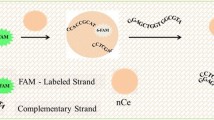Abstract
Quantitative analysis of interactions between small molecules and proteins is a central challenge in chemical genetics, molecular diagnostics and drug developments. Here, we developed a RNA transcription nanomachine by assembling T7 RNA polymerase on a small molecule-labeled DNA heteroduplex. The nanomachine, of which the RNA transcription activity can be quantitatively inhibited by protein binding, showed a great potential for small molecule-protein interaction assay. This finding enabled us to develop a novel homogeneous label-free strategy for assays of interactions between small molecules and their protein receptors. Three small molecule compounds and their protein receptors have been used to demonstrate the developed strategy. The results revealed that the protein-small molecule interaction assay strategy shows dynamic responses in the concentration range from 0.5 to 64 nM with a detection limit of 0.2 nM. Due to its label-free, homogeneous, and fluorescence-based detection format, besides its desirable sensitivity this technique could be greatly robust, cost-efficient and readily automated, implying that the developed small molecule-protein interaction assay strategy might create a new methodology for develo** intrinsically robust, sensitive and selective platforms for homogeneous protein detection.
Similar content being viewed by others
References
Stockwell BR. Exploring biology with small organic molecules. Nature, 2004, 432: 846–854
Wang WU, Chen C, Lin KH, Fang Y, Lieber CM. Label-free detection of small-molecule-protein interactions by using nanowire nanosensors. Proc Natl Acad Sci USA, 2005, 102: 3208–3212
Rossi AM, Taylor CW. Analysis of protein-ligand interactions by fluorescence polarization. Nat Protoc, 2011, 6: 365–387
Koehler AN. A complex task? Direct modulation of transcription factors with small molecules. Curr Opin Chem Biol, 2010, 14: 331–340
Rich RL, Hoth LR, Geoghegan KF, Brown TA, LeMotte PK, Simons SP, Hensley P, Myszka DG. Kinetic analysis of estrogen receptor/ligand interactions. Proc Natl Acad Sci USA, 2002, 99: 8562–8567
Köster H, Little DP, Luan P, Muller R, Siddiqi SM, Marappan S, Yip P. Capture compound mass spectrometry: A technology for the investigation of small molecule protein interactions. Assay Drug Dev Techn, 2007, 5: 381–390
Kada G, Kaiser K, Falk H, Gruber HJ. Rapid estimation of avidin and streptavidin by fluorescence quenching or fluorescence polarization. Biochim Biophys Acta, 1999, 1427: 44–48
Kerppola TK. Visualization of molecular interactions by fluorescence complementation. Nat Rev Mol Cell Biol, 2006, 7: 449–456
Goldman ER, Medintz IL, Whitley JL, Hayhurst A, Clapp AR, Tetsuo Uyeda H, Deschamps JR, Lassman ME, Mattoussi HA. Hybrid quantum dot-antibody fragment fluorescence resonance energy transfer-based TNT sensor. J Am Chem Soc, 2005, 127: 6744–6751
Sugita R, Mie M, Funabashi H, Kobatake E. Evaluation of small ligand-protein interaction by ligation reaction with DNA-modified ligand. Biotechnol Lett, 2010, 32: 97–102
Gao LZ, Zhuang J, Nie L, Zhang JB, Zhang Y, Gu N, Wang TH, Feng J, Yang DL, Perrett S, Yan XY. Intrinsic peroxidase-like activity of ferromagnetic nanoparticles. Nat Nanotechnol, 2007, 2: 577–583
Liu GD, Lin YY, Wang J, Wu H, Wai CM, Lin YH. Disposable electrochemical immunosensor diagnosis device based on nanoparticle probe and immunochromatographic strip. Anal Chem, 2007, 79: 7644–7653
Shaikh NA, Ge J, Zhao YX, Walker P, Drebot M. Development of a novel, rapid, and sensitive immunochromatographic strip assay specific for West Nile Virus (WNV) IgM and testing of its diagnostic accuracy in patients suspected of WNV infection. Clin Chem, 2007, 53: 2031–2034
McGregor LM, Gorin DJ, Dumelin CE, Liu DR. Interaction-dependent PCR: Identification of ligand target pairs from libraries of ligands and libraries of targets in a single solution-phase experiment. J Am Chem Soc, 2010, 132: 15522–15524
Wu Z, Zhen Z, Jiang JH, Shen GL, Yu RQ. Terminal protection of small-molecule-linked DNA for sensitive electrochemical detection of protein binding via selective carbon nanotube assembly. J Am Chem Soc, 2009, 131: 12325–12332
Wu Z, Wang HQ, Guo M, Tang LJ, Yu RQ, Jiang JH. Terminal protection of small molecule-linked DNA: A versatile biosensor platform for protein binding and gene ty** assay. Anal Chem, 2011, 83: 3104–3111
Rong M, He B, McAllister WT, Durbin RK. Promoter specificity determinants of T7 RNA polymerase. Proc Natl Acad Sci USA, 1998, 95: 515–519
Mie M, Sugita R, Endoh T, Kobatake E. Evaluation of small ligand-protein interactions by using T7 RNA polymerase with DNA-modified ligand. Anal Biochem, 2010, 405: 109–113
Dittmer WU, Simmel FC. Transcriptional control of DNA-based nanomachines. Nano Lett, 2004, 4: 689–691
Pomerantz RT, Ramjit R, Gueroui Z, Place C, Anikin M, Leuba S, Zlatanova J, McAllister WT. A tightly regulated molecular motor based upon T7 RNA polymerase. Nano Lett, 2005, 5: 1698–1703
Han G, You CC, Kim B, Turingan RS, Forbes NS, Martin CT, Rotello VM. Light-regulated release of DNA and its delivery to nuclei by means of photolabile gold nanoparticles. Angew Chem Int Ed, 2006, 45: 3165–3169
Grate D, Wilson C. Laser-mediated, site-specific inactivation of RNA transcripts. Proc Natl Acad Sci USA, 1999, 96: 6131–6136
Babendure JR, Babendure SR, Tsien RY. Aptamers switch on fluorescence of triphenylmethane dyes. J Am Chem Soc, 2003, 125: 14716–14717
Fahlman RP, Sen D. DNA conformational switches as sensitive electronic sensors of analytes. J Am Chem Soc, 2002, 124: 4610–4616
Bayer EA, Wilchek M. Biotin-binding proteins: Overview and prospects. Methods Enzymol, 1990, 184: 49–51
Author information
Authors and Affiliations
Corresponding authors
Rights and permissions
About this article
Cite this article
Zhou, D., Wu, Y., Liu, P. et al. Homogeneous label-free fluorescent assay of small molecule-protein interactions using protein binding-inhibited transcription nanomachine. Sci. China Chem. 54, 1277–1283 (2011). https://doi.org/10.1007/s11426-011-4337-4
Received:
Accepted:
Published:
Issue Date:
DOI: https://doi.org/10.1007/s11426-011-4337-4




